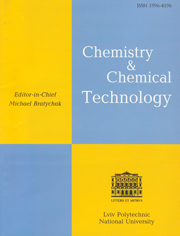Removal of Methylene Blue by Adsorption onto Activated Carbons Produced from Agricultural Wastes by Microwave Induced KOH Activation
| Attachment | Size |
|---|---|
| 1.56 MB |
[1] Batzias F., Sidiras D.: Bioresour. Technol., 2007, 98, 1208. https://doi.org/10.1016/j.biortech.2006.05.020
[2] Tan I., Hameed B., Ahmad A.: Chem. Eng. J., 2007, 127, 111. https://doi.org/10.1016/j.cej.2006.09.010
[3] Ghosh D., Bhattacharyya K.: Appl. Clay Sci., 2002, 20, 295300. https://doi.org/10.1016/S0169-1317(01)00081-3
[4] Robinson T., McMullan G., Marchant R., Nigam P.: Bioresour. Technol., 2001, 77, 247. https://doi.org/10.1016/S0960-8524(00)00080-8
[5] Robinson T., Chandran B., Nigam P.: Water Res., 2002, 36, 2824. https://doi.org/10.1016/S0043-1354(01)00521-8
[6] Qi J., Li Z., Guo Y., Xu H.: Mater. Chem. Phys., 2004, 87, 96. https://doi.org/10.1016/j.matchemphys.2004.05.008
[7] Foo K., Hameed B.: Biomass Bioenerg., 2011, 35, 3257. https://doi.org/10.1016/j.biombioe.2011.04.023
[8] Foo K., Hameed B.: Chem. Eng. J., 2012, 187, 53. https://doi.org/10.1016/j.cej.2012.01.079
[9] Foo K., Hameed B.: Chem. Eng. J., 2012, 184, 57. https://doi.org/10.1016/j.cej.2011.12.084
[10] Djilani C., Zaghdoudi R., Modarressi A. et al.: Chem. Eng. J., 2012, 189-190, 203. https://doi.org/10.1016/j.cej.2012.02.059
[11] Ozdemir I., Sahin M., Orhan R., Erdem M.: Technol., 2014, 125, 200.
[12] Farinella N., Matos G., Arruda M.: Technol., 2007, 98, 1940.
[13] Deiana A., Sardella M., Silva H. et al.: J. Hazard. Mater., 2009, 172,13. https://doi.org/10.1016/j.jhazmat.2009.06.095
[14] Ghaedi M., Biyareh M., Kokhdan S. et al.: Mater. Sci. Eng. C, 2012, 32, 725. https://doi.org/10.1016/j.msec.2012.01.015
[15] Zhu L., Chen B., Shen X.: Environ. Sci. Technol., 2000, 34, 468. https://doi.org/10.1021/es990177x
[16] Dogan M., Ozdemir Y., Alkan M.: Dyes Pigments, 2007, 75, 701. https://doi.org/10.1016/j.dyepig.2006.07.023
[17] Eftekhari S., Habibi-Yangjeh A., Sohrabnezhad S.: J. Hazard. Mater., 2010, 178, 349. https://doi.org/10.1016/j.jhazmat.2010.01.086
[18] Dawood S., Kanti Sen T.: Water Res., 2012, 46, 1933. https://doi.org/10.1016/j.watres.2012.01.009
[19] Giles C., MacEwan T., Nakhwa S., Smith D.: J. Chem. Soc., 1960, 10, 3973. https://doi.org/10.1039/jr9600003973
[20] Gurses A., Dogar C., Yalcin M. et al.: J. Hazard. Mater., 2006, 131, 217. https://doi.org/10.1016/j.jhazmat.2005.09.036
[21] Langmuir I.: J. Am. Chem. Soc., 1918, 40, 1361. https://doi.org/10.1021/ja02242a004
[22] Mechati F., Bouchelta C., Medjram M. et al.: J. Environ. Chem. Eng., 2015, 3, 1928. https://doi.org/10.1016/j.jece.2015.07.007
[23] Hamdaoui O., Naffrechoux E.: J. Hazard. Mater., 2007, 147, 381. https://doi.org/10.1016/j.jhazmat.2007.01.021
[24] Abuzer C., Gizem Ilgun E., Bozkurt H.: Chem. Eng. J., 2012, 191, 228. https://doi.org/10.1016/j.cej.2012.03.007
[25] Kumar P., Ramalingam S., Senthamarai C. et al.: Desalin., 2010, 261, 52. https://doi.org/10.1016/j.desal.2010.05.032
[26] Tahir S., Rauf N.: Chemosphere, 2006, 63, 1842. https://doi.org/10.1016/j.chemosphere.2005.10.033










